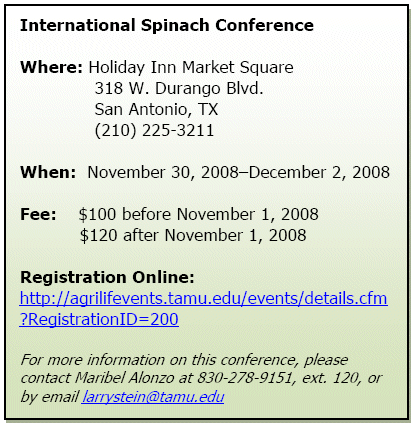AG-ECO NEWS
Vol. 24, Issue 29, October 8, 2008 – PDF version
Jose G. Peña
Texas AgriLife Extension Economist-Management
Spinach Production Important to Texas
International Spinach Conference In San Antonio, December 1, 2008
Spinach production is very important to Texas and especially to the southwest Wintergarden region of Texas where close to 90 percent of the spinach produced in Texas is grown. Spinach planting is underway and the harvest should start by early November.
While Texas dominated the spinach industry and led in production for the fresh market until the mid-80’s, California now leads the nation, producing about 78 percent of the 831 million pounds of spinach produced in the U.S. in 2007. Texas now produces about nine percent of total U.S. production compared to the mid-80’s, when it produced close to 40%. In addition, production for the fresh market has decreased substantially in Texas. Texas ranks a very distant 3rd in production for the fresh market, behind California and Arizona, producing only about 2.0% of the 635.4 million pounds produced in 2007. (See Figure 1). Texas ranks 2nd in production for the processed market behind California, which produced about 32 percent of the 195.6 million pounds of spinach grown for the processed market in 2007. 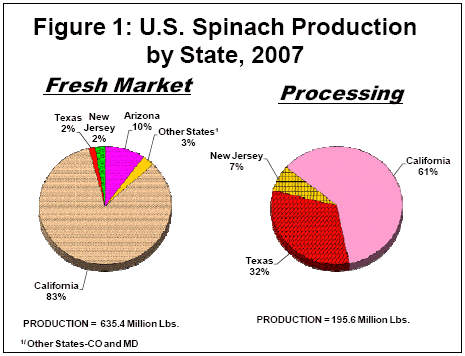
Growing Demand
Demand is growing for fresh vegetables, after a slight decline during 2005-06, which was probably influenced by the spinach E-coli crisis. Per capita use of all vegetables is forecast to total 444 pounds in 2008, up 9.7 pounds from 434.3 pounds in 2006. Demand is especially high for attractive, high quality greens with good taste and high nutritional value. Per capita consumption of romaine lettuce alone has almost tripled during the last few years to 15.3 pounds forecast in 2008, compared to an average of about 4.0 pounds during 1985-1995 and just a trace prior to 1985. This increased demand has helped boost demand and prices for spinach.
Spinach falls into the category of high quality, nutrition-packed, leafy greens with excellent taste. While total per capita consumption (canning, freezing and fresh) (Figure 2) dipped slightly during the mid-80’s, and again after the spinach E-coli crisis, per capita consumption has been showing increases, increasing to about 2.8 lbs during 2007, up 1.0 lb from an average of 1.8 lbs in the 90’s. While processed spinach consumption increased slightly after the spinach E-coli crisis, most of the increased per capita spinach consumption has been for the fresh market to an average of 2.0 pounds during the last two years compared to an average of 0.8 pounds during 1992-1999. Fresh spinach consumption, however, remains just a small blip (about 6%) in relation to total per capita consumption of head and leaf lettuce at about 35.4 pounds in 2007. 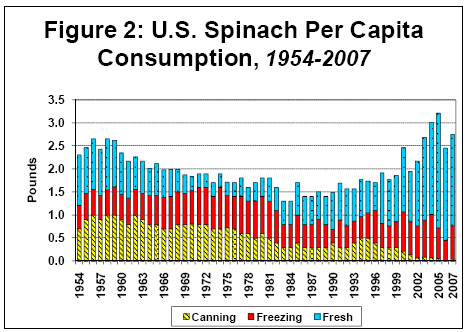
It is interesting to note that production for the processed market increased to about 195 million pounds in 2007 after two years of declines (Figure 3). While most of the increased production for the processed market has been in frozen spinach, it is also interesting to note a significant increase in the production for canning in 2007 to 29.4 million pounds, up 8.36 million pounds from 8.4 million pounds produced in 2006, but down 64.0 percent from 81.6 million pounds produced ten years ago in 1999. While some processed spinach production in Texas goes to freezing plants, most of the current production goes to canning.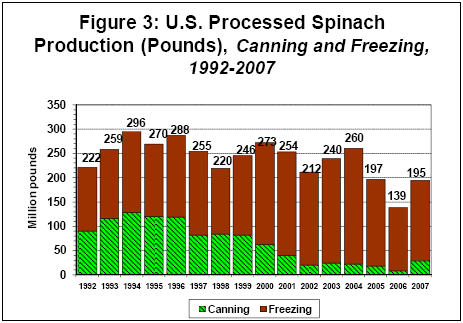
While per capita consumption of all forms of lettuce exceeds spinach consumption, spinach is, by far, a superior product in attractiveness, nutritional value and flexibility in use i.e., can be used fresh and/or in a large variety of cooking options. Since only about 5.3% of the 37.4 pound per capita consumption of head lettuce romaine and spinach, consists of spinach, it appears that market opportunities for increased spinach consumption may be available by capturing part of total lettuce market shares. The industry must increase public awareness of the nutritional value of spinach, especially as it concerns cancer prevention, antioxidants, and neutraceuticals (food pharmaceuticals) and emphasize the major changes which have been implemented to reduce contamination problems. Fruits, vegetables, nuts and whole grains contain an abundance of phytonutrients that have been associated with protection from and/or treatment of chronic diseases including coronary heart disease, various types of cancer, eye disorders, diabetes, stroke and hypertension. Spinach remains among the top in the list of nutritious vegetables.
Spinach Value
The farm value of spinach production in Texas (fresh and processed) during 2008 amounted to $4.9 million ($2.53 million processed, $2.4 million fresh)
with an economic impact of about $11.0 million for communities in Southwest Texas. (See Figure 4). 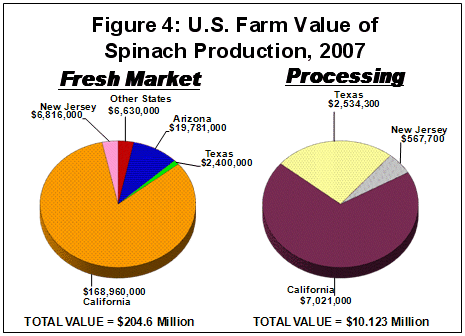
International Spinach Conference
The 4th annual international spinach conference is scheduled to be conducted in San Antonio during the November 30-December 2, 2008 where spinach growers, shippers and industry leaders from Canada, Denmark, the Netherlands and at least eight U.S. states are expected to attend. 